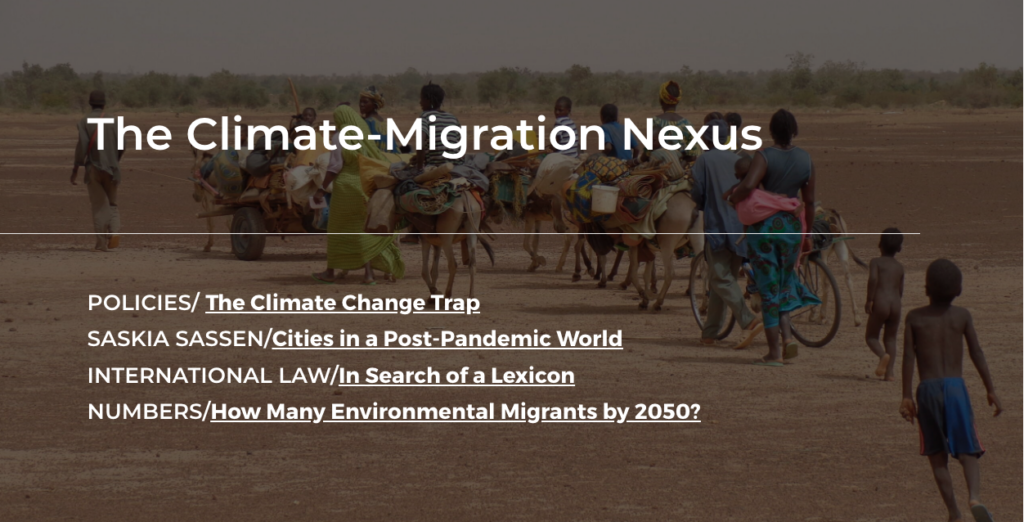“We have lost our innocence”. Cities are threatened by climate change and play a central role in the transition towards sustainable development. One of the most critical factors? Food and its production. Professor Saskia Sassen explains how global environmental challenges are particularly tangible and urgent in cities, which become the place where opportunities and solutions for positive change can be developed. Especially by young generations in a world that needs to recover from COVID-19.

With two-thirds of the global population predicted to live in cities by 2050, the issue of how cities and urban migrations will shape the future is becoming a central facet of environmental thinking. In fact, the growth of cities across the globe goes hand in hand with both increased potential for environmental damage but also the creation of innovative solutions. As a student of cities, immigration, and states in the world economy, with inequality, gendering and digitization, three key variables running throughout her work, Professor Saskia Sassen is perfectly poised to answer some of these pressing questions. She believes that: “much of what we keep describing as global environmental challenges become tangible and urgent in cities. Cities are at the centre of our environmental future.” Professor Sassen provides insight into the role of modern cities and how they can react to increased migrations and climate-induced adversity with measures that also provide environmental contributions.
Climate change is definitely threatening a large amount of cities. We must recognize that the ground has shifted… we have lost our innocence.
As more and more people move to urban centres cities will take on an increasingly important role in shaping the future. What sort of problems will this transition bring?
In today’s world we are increasingly aware of climate change and the rising fragility of more and more cities – due to flooding, overpopulation, the challenge of securing food for cities, and other reasons. A crucial aspect is that of food and it is not just a question of households having the money to buy food, it is also the fact of expanding urban areas where there is not enough food available. European cities are perhaps an exception in that they tend to be small and have long secured the option of growing some food in the cities themselves –something that is far more difficult in the major urban centres of the Americas.

Click and read the full story
What can be done to solve the problem of food shortage in cities?
Cities are key actors that we should see as one of the most direct places for growing food. This would also avoid shipping and trucks bringing in food, with a consequent reduction in pollution. We have to move much faster than we are doing now to recover the critical role of urban space in the development of alternative modes of securing life and food.
Climate change is also leading to migrations from rural to urban areas (particularly into slums or low-income neighbourhoods), and from low to higher-income countries. Do we need to change the way cities are structured?
Yes, this is a concern. We cannot keep organizing our cities the way we are now, especially in the Americas and in Asia. In contrast, European cities are the exception and tend to be much smaller and more manageable. This is in good part because they emerged from an older epoch when self-sufficiency was an important and recognized aim and an option, even if partial. Therefore, we must encourage cities to return to models of self-sufficiency.
One of the outstanding features that are evident when one examines a range of today’s major cities is the pronounced differences among them in environmental sustainability.
from Cities are at the center of our environmental future
Cities are becoming ever larger and it is predicted that there will be over 43 megacities (and hence with a population of over 10 million people) across the globe by 2050. Is this trend part of the problem or a potential solution to environmental concerns?
We need to build many new cities that are reasonable in size and which enable residents rather than forcing them into very long commutes. We need what European cities have: small gardens where you can grow some basic foods easily. And we need to prioritize the wellbeing of all rather than the money racket we are increasingly confronting. We cannot reduce cities to the status of money makers — which is what is happening with more and more of our great cities, especially the big ones.
Cities contain the networks and information loops that may facilitate communicating, informing, and persuading households, governments, and firms to support and participate in environmentally-sensitive programs and radically transformative institution-building.
from Cities are at the center of our environmental future
A large number of cities are vulnerable to the effects of climate change. What can be done to create resilience in cities?
Climate change is definitely threatening a large number of cities. We must recognize that the ground has shifted… we have lost our innocence. I think more and more entities – universities, municipal governments, young students, and so much more – are now focusing on the environmental challenge. Cities are certainly a major – and easy to criticize – facet of our lives that young people are engaging in a way they did not even just a few years ago.
In the context of the COVID-19 pandemic do you see any new opportunities emerging for cities to change?
One possible hidden opportunity is the fact that being confined to one’s home might move us to get more engaged with one’s neighbours and one’s street. It could help us care more, make us want to see some plants and flowers, and make the little repairs that we never had time for before.
There is a lot of talk about how developing countries will be affected by the pandemic. Do you think this is a realistic concern?
This is the really worrisome issue: many developing countries may not have the necessary resources to address the challenges that are increasingly going to become more severe. Poor neighbourhoods in cities where rising waters might be a problem will be hit especially hard and in particular, the poorer areas and neighbourhoods are at risk of losing everything.
How has the way environmental issues are being tackled changed since the Covid-19 crisis started?
These negative conditions will generate opportunities for new types of research and discourses on climate change. We must gather information on a very broad range of conditions that in many ways we neglected, or could not recognize, given existing research modes. The new generations are often far more in tune with these conditions than researchers in the past.







